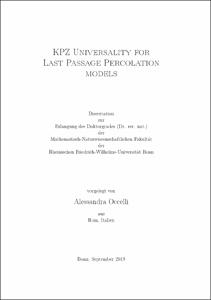KPZ universality for last passage percolation models

KPZ universality for last passage percolation models

| dc.contributor.advisor | Ferrari, Patrik L. | |
| dc.contributor.author | Occelli, Alessandra | |
| dc.date.accessioned | 2020-04-26T22:53:20Z | |
| dc.date.available | 2020-04-26T22:53:20Z | |
| dc.date.issued | 12.09.2019 | |
| dc.identifier.uri | https://hdl.handle.net/20.500.11811/8071 | |
| dc.description.abstract | In this thesis we consider models of last passage percolation on the ℤ2. These models belong to the Kardar–Parisi–Zhang universality class, a class of stochastic growth models that have been widely studied in the last 30 years. Last passage percolation models provide a “physical” description of combinatoric problems, such as the Ulam’s problem, in terms of zero temperature directed polymers, but also a geometrical interpretation of an interacting particle system, the totally asymmetric simple exclusion process (TASEP). Moreover, in the large time limit, they share statistical features with certain ensembles of random matrices. We investigate the universality of the limit distributions of the last passage time for different settings. First, we study TASEP starting from a periodic configuration and show the universality of the GOE Tracy-Widom distribution for generic particle density. This result is proved in the last passage percolation framework and is obtained with soft probabilistic arguments, as the convergence of the last passage time to a variational formula involving the limit Airy2 process. Then, we analyze the correlations of two last passage times for different ending points in a neighbourhood of the characteristic. For the standard settings (step, flat and stationary), using similar techniques, we prove the converge of the covariance of the last passage times to the covariance of the limiting processes. For a more general class of random initial conditions, we prove the universality of the first order correction when the two observation times are close and provide a rigorous bound of the error term. Finally, we consider a model of last passage percolation on half-space. We show that the stationary initial condition can be realized by adding weights on the axis and on the diagonal, and we obtain the distribution of the last passage time for this configuration. The limit distribution is analogous to the Baik–Rains distribution from the case of stationary full-space last passage percolation, but in our case, it depends on a parameter, the strength of the weights on the diagonal. | en |
| dc.language.iso | eng | |
| dc.rights | In Copyright | |
| dc.rights.uri | http://rightsstatements.org/vocab/InC/1.0/ | |
| dc.subject.ddc | 510 Mathematik | |
| dc.title | KPZ universality for last passage percolation models | |
| dc.type | Dissertation oder Habilitation | |
| dc.publisher.name | Universitäts- und Landesbibliothek Bonn | |
| dc.publisher.location | Bonn | |
| dc.rights.accessRights | openAccess | |
| dc.identifier.urn | https://nbn-resolving.org/urn:nbn:de:hbz:5n-55707 | |
| ulbbn.pubtype | Erstveröffentlichung | |
| ulbbnediss.affiliation.name | Rheinische Friedrich-Wilhelms-Universität Bonn | |
| ulbbnediss.affiliation.location | Bonn | |
| ulbbnediss.thesis.level | Dissertation | |
| ulbbnediss.dissID | 5570 | |
| ulbbnediss.date.accepted | 05.09.2019 | |
| ulbbnediss.fakultaet | Mathematisch-Naturwissenschaftliche Fakultät | |
| dc.contributor.coReferee | Disertori, Margherita |
Files in this item
This item appears in the following Collection(s)
-
E-Dissertationen (4379)




